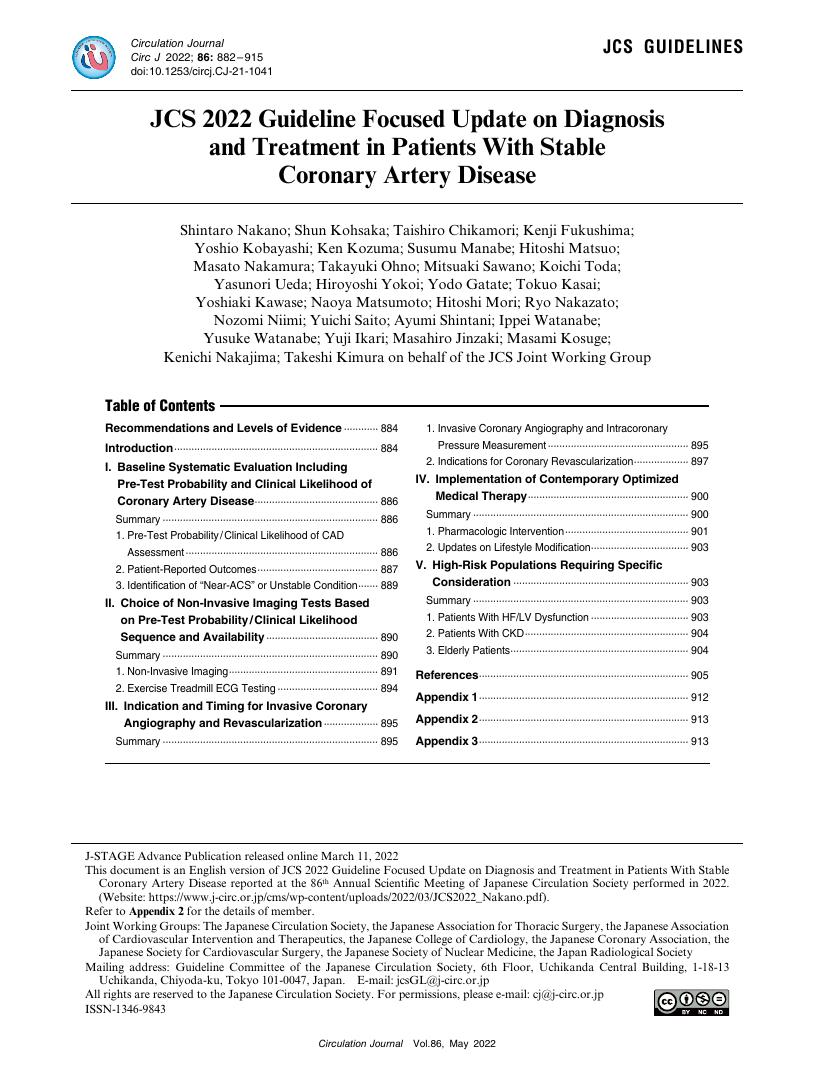11 0 0 0 OA JCS 2022 Guideline Focused Update on Diagnosis and Treatment in Patients With Stable Coronary Artery Disease
- 著者
- Shintaro Nakano Shun Kohsaka Taishiro Chikamori Kenji Fukushima Yoshio Kobayashi Ken Kozuma Susumu Manabe Hitoshi Matsuo Masato Nakamura Takayuki Ohno Mitsuaki Sawano Koichi Toda Yasunori Ueda Hiroyoshi Yokoi Yodo Gatate Tokuo Kasai Yoshiaki Kawase Naoya Matsumoto Hitoshi Mori Ryo Nakazato Nozomi Niimi Yuichi Saito Ayumi Shintani Ippei Watanabe Yusuke Watanabe Yuji Ikari Masahiro Jinzaki Masami Kosuge Kenichi Nakajima Takeshi Kimura on behalf of the JCS Joint Working Group
- 出版者
- The Japanese Circulation Society
- 雑誌
- Circulation Journal (ISSN:13469843)
- 巻号頁・発行日
- pp.CJ-21-1041, (Released:2022-03-11)
- 参考文献数
- 245
- 被引用文献数
- 40
- 著者
- Takahiro Kobayashi Hideki Kitahara Ken Kato Yuichi Saito Yoshio Kobayashi
- 出版者
- The Japanese Circulation Society
- 雑誌
- Circulation Journal (ISSN:13469843)
- 巻号頁・発行日
- pp.CJ-22-0202, (Released:2022-08-27)
- 参考文献数
- 30
- 被引用文献数
- 4
Background: Dialysis patients have strong intracoronary calcification, accelerated by secondary hyperparathyroidism as well as atherosclerosis. We evaluated the association of intact parathyroid hormone (iPTH) level with intracoronary calcification evaluated by intravascular ultrasound (IVUS), and its impact on both stent expansion after percutaneous coronary intervention (PCI) and long-term clinical outcomes, in dialysis patients with coronary artery disease (CAD).Methods and Results: A total of 116 patients on dialysis, who underwent PCI with IVUS guidance between March 2012 and December 2020, were enrolled. Patients were divided into 2 groups based on their median iPTH level. The degree of intracoronary calcification was evaluated by calcification score using grayscale IVUS in the target lesions. Preprocedural calcification scores were significantly higher in the high iPTH group compared with the low iPTH group (2.9±1.1 vs. 2.1±0.7, P<0.001). After PCI, the high iPTH group had a significantly lower stent expansion index (0.6±0.2 vs. 0.7±0.1, P<0.001) and stent symmetry index (0.5±0.1 vs. 0.7±0.1, P<0.001) compared with the low iPTH group. The incidence of major adverse cardiac or cerebrovascular events within 3 years was significantly higher in the high iPTH group (log-rank P<0.05).Conclusions: High iPTH level is likely to increase intracoronary calcification, and cause inadequate stent expansion, which may be associated with increased risk of future adverse events in dialysis patients with CAD requiring PCI.
- 著者
- Shintaro Nakano Shun Kohsaka Taishiro Chikamori Kenji Fukushima Yoshio Kobayashi Ken Kozuma Susumu Manabe Hitoshi Matsuo Masato Nakamura Takayuki Ohno Mitsuaki Sawano Koichi Toda Yasunori Ueda Hiroyoshi Yokoi Yodo Gatate Tokuo Kasai Yoshiaki Kawase Naoya Matsumoto Hitoshi Mori Ryo Nakazato Nozomi Niimi Yuichi Saito Ayumi Shintani Ippei Watanabe Yusuke Watanabe Yuji Ikari Masahiro Jinzaki Masami Kosuge Kenichi Nakajima Takeshi Kimura on behalf of the JCS Joint Working Group
- 出版者
- The Japanese Circulation Society
- 雑誌
- Circulation Journal (ISSN:13469843)
- 巻号頁・発行日
- vol.86, no.5, pp.882-915, 2022-04-25 (Released:2022-04-25)
- 参考文献数
- 245
- 被引用文献数
- 40
- 著者
- Yuichi Saito Hiroyuki Okuyoshi Shinsuke Nakamura Wataru Otsu Akihiro Yamaguchi Peter F. Hitchcock Mikiko Nagashima Masamitsu Shimazawa Hideaki Hara
- 出版者
- The Pharmaceutical Society of Japan
- 雑誌
- BPB Reports (ISSN:2434432X)
- 巻号頁・発行日
- vol.3, no.3, pp.92-96, 2020 (Released:2020-11-26)
- 参考文献数
- 37
Regenerative medicine aims to replenish damaged tissue. Boosting the capacity of intrinsic stem cells to proliferate is one key for successful regeneration. Adult zebrafish possess tissue resident stem and progenitor cells, which contribute to homeostatic growth and tissue regeneration. In the intact retina, Müller glia sporadically divide to generate fate restricted, proliferative precursors. Cell death reprograms Müller glia into stem cells that divide and produce multi-potent retinal progenitors. Using zebrafish, we evaluated the effect of taurine-conjugated bile acid, Tauroursodeoxycholic acid (TUDCA) on retinal regeneration. In the intact retina, treatment with TUDCA significantly promotes proliferation of the fate restricted precursors, but has no effect on Müller glia. Following constant light exposure, TUDCA attenuates photoreceptor death, indicating that TUDCA is neuroprotective. Following a stab wound, which initiates death of retinal neurons and reprogramming of Müller glia, treatment with TUDCA significantly increases the number of proliferating cells. In the intact retina, TUDCA-induced proliferation was accompanied by decreased expression of cell cycle inhibitors. These results suggest that TUDCA promotes proliferation of actively-cycling stem and progenitors, identifying TUDCA as a potential reagent to promote regeneration of retinal neurons.
